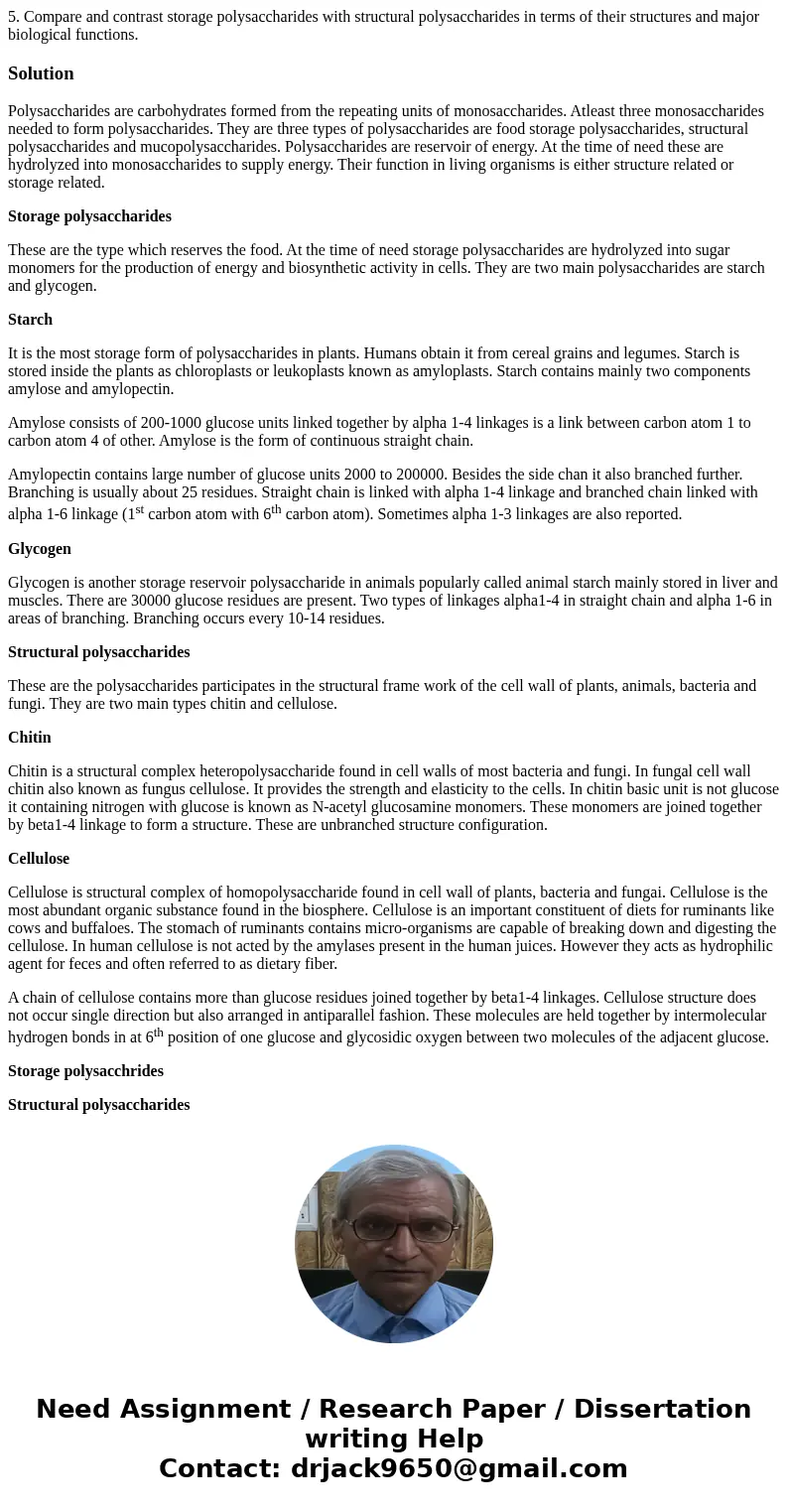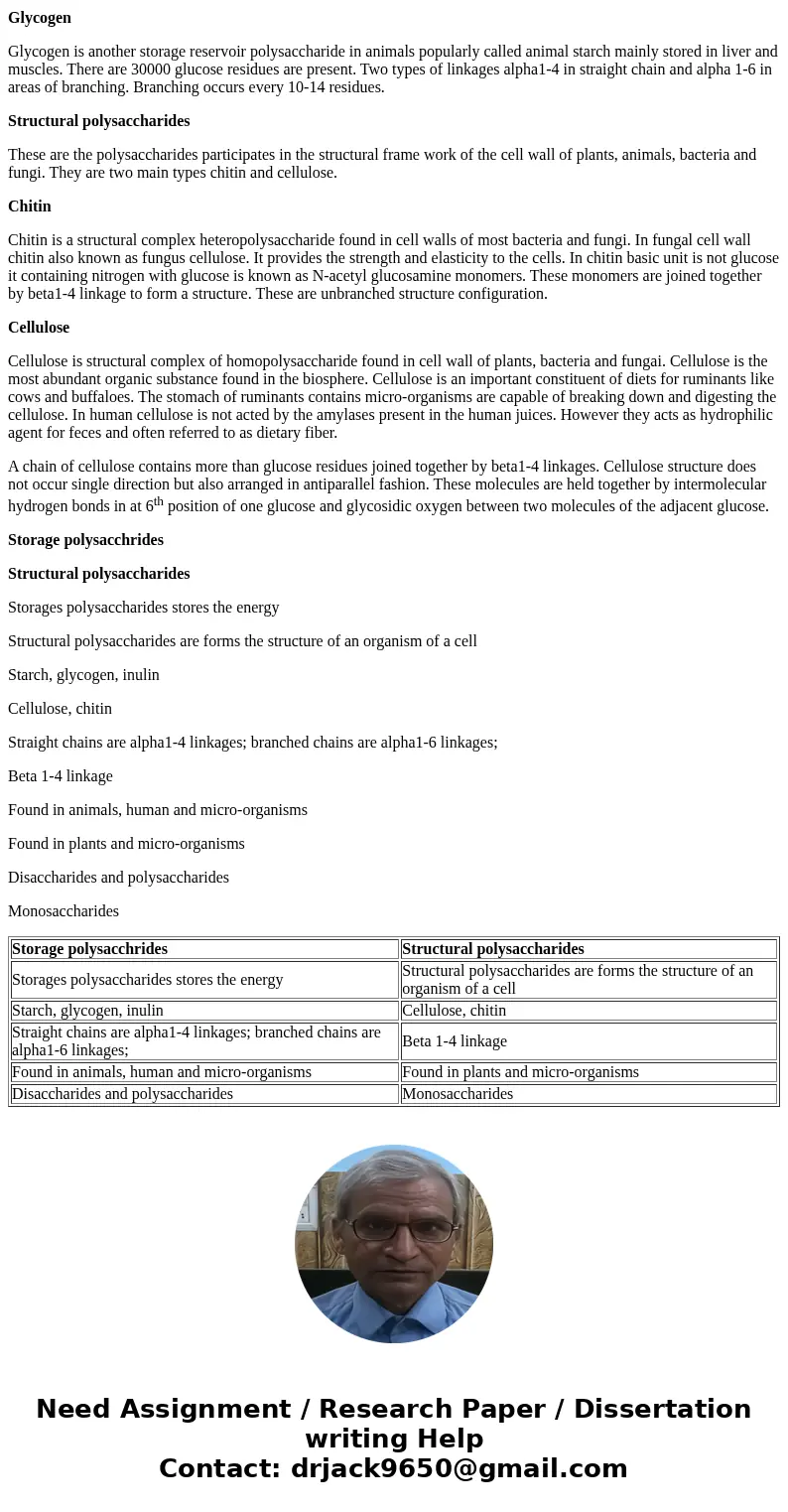5 Compare and contrast storage polysaccharides with structur
5. Compare and contrast storage polysaccharides with structural polysaccharides in terms of their structures and major biological functions.
Solution
Polysaccharides are carbohydrates formed from the repeating units of monosaccharides. Atleast three monosaccharides needed to form polysaccharides. They are three types of polysaccharides are food storage polysaccharides, structural polysaccharides and mucopolysaccharides. Polysaccharides are reservoir of energy. At the time of need these are hydrolyzed into monosaccharides to supply energy. Their function in living organisms is either structure related or storage related.
Storage polysaccharides
These are the type which reserves the food. At the time of need storage polysaccharides are hydrolyzed into sugar monomers for the production of energy and biosynthetic activity in cells. They are two main polysaccharides are starch and glycogen.
Starch
It is the most storage form of polysaccharides in plants. Humans obtain it from cereal grains and legumes. Starch is stored inside the plants as chloroplasts or leukoplasts known as amyloplasts. Starch contains mainly two components amylose and amylopectin.
Amylose consists of 200-1000 glucose units linked together by alpha 1-4 linkages is a link between carbon atom 1 to carbon atom 4 of other. Amylose is the form of continuous straight chain.
Amylopectin contains large number of glucose units 2000 to 200000. Besides the side chan it also branched further. Branching is usually about 25 residues. Straight chain is linked with alpha 1-4 linkage and branched chain linked with alpha 1-6 linkage (1st carbon atom with 6th carbon atom). Sometimes alpha 1-3 linkages are also reported.
Glycogen
Glycogen is another storage reservoir polysaccharide in animals popularly called animal starch mainly stored in liver and muscles. There are 30000 glucose residues are present. Two types of linkages alpha1-4 in straight chain and alpha 1-6 in areas of branching. Branching occurs every 10-14 residues.
Structural polysaccharides
These are the polysaccharides participates in the structural frame work of the cell wall of plants, animals, bacteria and fungi. They are two main types chitin and cellulose.
Chitin
Chitin is a structural complex heteropolysaccharide found in cell walls of most bacteria and fungi. In fungal cell wall chitin also known as fungus cellulose. It provides the strength and elasticity to the cells. In chitin basic unit is not glucose it containing nitrogen with glucose is known as N-acetyl glucosamine monomers. These monomers are joined together by beta1-4 linkage to form a structure. These are unbranched structure configuration.
Cellulose
Cellulose is structural complex of homopolysaccharide found in cell wall of plants, bacteria and fungai. Cellulose is the most abundant organic substance found in the biosphere. Cellulose is an important constituent of diets for ruminants like cows and buffaloes. The stomach of ruminants contains micro-organisms are capable of breaking down and digesting the cellulose. In human cellulose is not acted by the amylases present in the human juices. However they acts as hydrophilic agent for feces and often referred to as dietary fiber.
A chain of cellulose contains more than glucose residues joined together by beta1-4 linkages. Cellulose structure does not occur single direction but also arranged in antiparallel fashion. These molecules are held together by intermolecular hydrogen bonds in at 6th position of one glucose and glycosidic oxygen between two molecules of the adjacent glucose.
Storage polysacchrides
Structural polysaccharides
Storages polysaccharides stores the energy
Structural polysaccharides are forms the structure of an organism of a cell
Starch, glycogen, inulin
Cellulose, chitin
Straight chains are alpha1-4 linkages; branched chains are alpha1-6 linkages;
Beta 1-4 linkage
Found in animals, human and micro-organisms
Found in plants and micro-organisms
Disaccharides and polysaccharides
Monosaccharides
| Storage polysacchrides | Structural polysaccharides |
| Storages polysaccharides stores the energy | Structural polysaccharides are forms the structure of an organism of a cell |
| Starch, glycogen, inulin | Cellulose, chitin |
| Straight chains are alpha1-4 linkages; branched chains are alpha1-6 linkages; | Beta 1-4 linkage |
| Found in animals, human and micro-organisms | Found in plants and micro-organisms |
| Disaccharides and polysaccharides | Monosaccharides |


 Homework Sourse
Homework Sourse